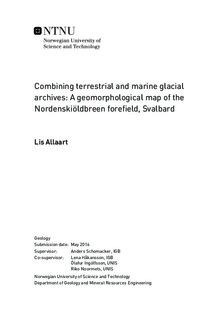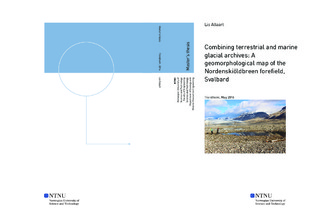| dc.description.abstract | Recent research suggests that Svalbard glaciers have retreated and thinned since the Little Ice Age. The analysis of glacial landforms and sediment deposits in the terrestrial and marine environments permits the reconstruction of the temporal and spatial variability of recent deglaciations. This study is founded on the analysis and interpretation of a geomorphological map (1:10000) of the foreland of Nordenskiöldbreen (inner Billefjorden, Svalbard). The map covers an area of ca. 43 km2 and is constructed from a combination of field observations and remotely sensed imagery from both the terrestrial and marine environments. Landforms are classified into six genetic categories: (1) subglacial, (2) ice-marginal, (3) supraglacial, (4) proglacial, (5) periglacial and (6) coastal. Glacier front positions from 1896 to present are reconstructed using historical data, oblique and vertical aerial imagery and LANDSAT and ASTER imagery. The preservation of the landform record differs between the terrestrial and marine archive. Previous studies of this region have focused on either marine or terrestrial archives and have failed to capture the complexities of the Nordenskiöldbreen forefield. As a result, pre-existing landsystem models are not applicable to Nordenskiöldbreen.
The results of this investigation suggest Nordenskiöldbreen has been a dynamic glacier with components of all Svalbard type glaciers. The retreat pattern reconstructed in this thesis indicates that water depth and bedrock pinning points (sills) played an important role in the antecedent stability of Nordenskiöldbreen. Additionally, existing landsystem models fail to capture the complexity of glaciers with a combined terrestrial and marine terminus such as Nordenskiöldbreen. The application of these models should therefore be carefully considered when investigating glaciers with a mixed terminus. This study contributes to an improved understanding of Svalbard glaciers and their response to recent climate fluctuations. | |

